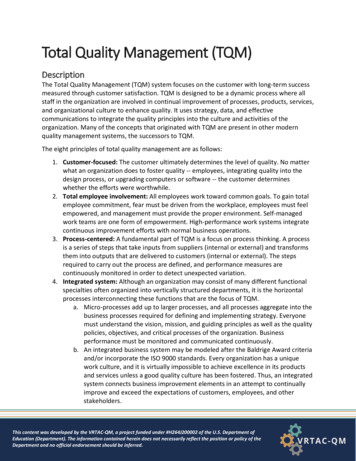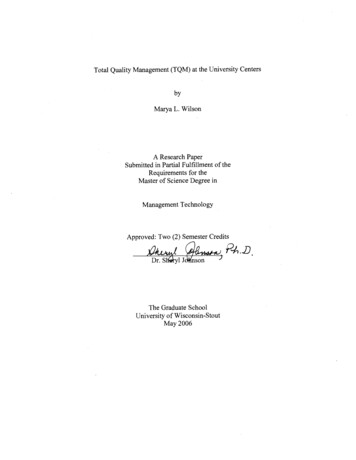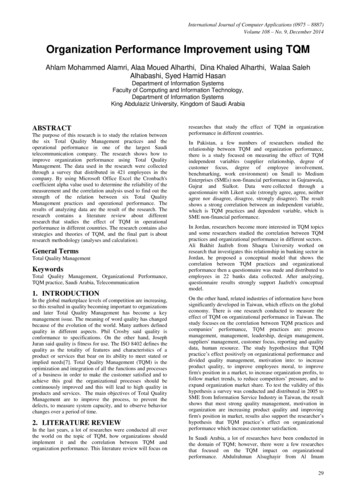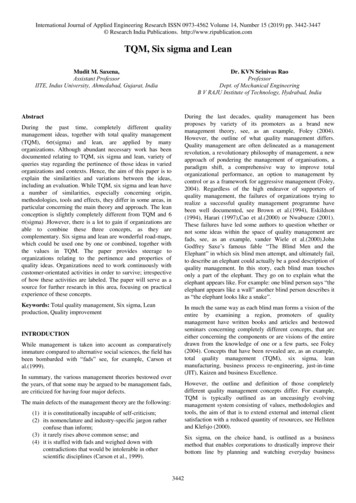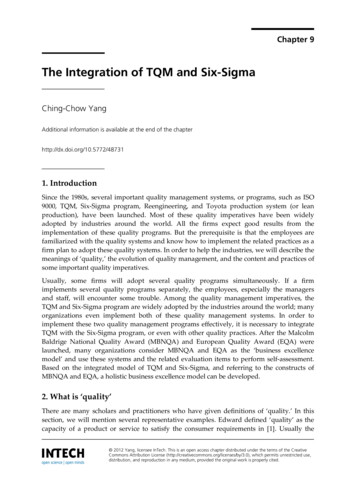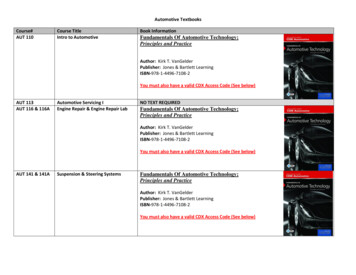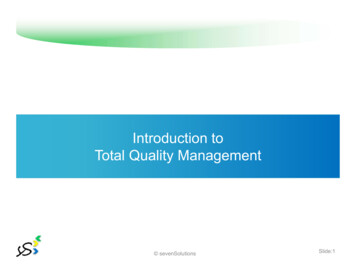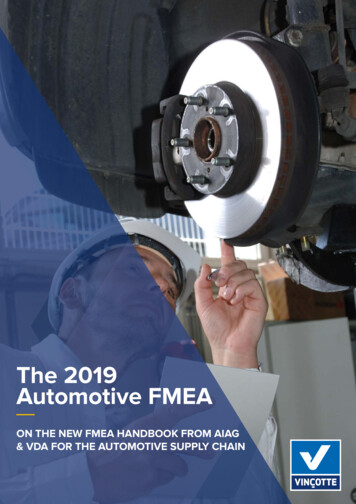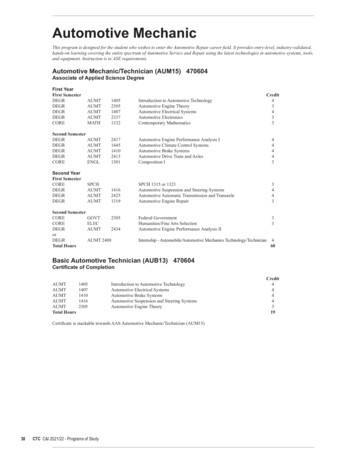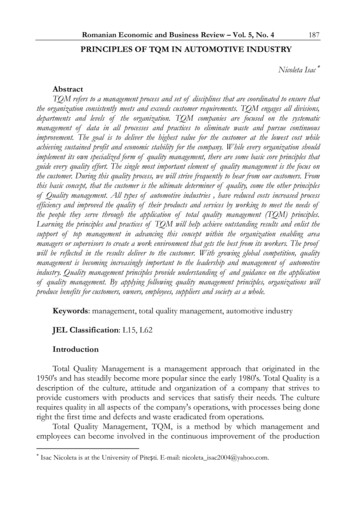
Transcription
Romanian Economic and Business Review – Vol. 5, No. 4187PRINCIPLES OF TQM IN AUTOMOTIVE INDUSTRYNicoleta Isac AbstractTQM refers to a management process and set of disciplines that are coordinated to ensure thatthe organization consistently meets and exceeds customer requirements. TQM engages all divisions,departments and levels of the organization. TQM companies are focused on the systematicmanagement of data in all processes and practices to eliminate waste and pursue continuousimprovement. The goal is to deliver the highest value for the customer at the lowest cost whileachieving sustained profit and economic stability for the company. While every organization shouldimplement its own specialized form of quality management, there are some basic core principles thatguide every quality effort. The single most important element of quality management is the focus onthe customer. During this quality process, we will strive frequently to hear from our customers. Fromthis basic concept, that the customer is the ultimate determiner of quality, come the other principlesof Quality management. All types of automotive industries , have reduced costs increased processefficiency and improved the quality of their products and services by working to meet the needs ofthe people they serve through the application of total quality management (TQM) principles.Learning the principles and practices of TQM will help achieve outstanding results and enlist thesupport of top management in advancing this concept within the organization enabling areamanagers or supervisors to create a work environment that gets the best from its workers. The proofwill be reflected in the results deliver to the customer. With growing global competition, qualitymanagement is becoming increasingly important to the leadership and management of automotiveindustry. Quality management principles provide understanding of and guidance on the applicationof quality management. By applying following quality management principles, organizations willproduce benefits for customers, owners, employees, suppliers and society as a whole.Keywords: management, total quality management, automotive industryJEL Classification: L15, L62IntroductionTotal Quality Management is a management approach that originated in the1950's and has steadily become more popular since the early 1980's. Total Quality is adescription of the culture, attitude and organization of a company that strives toprovide customers with products and services that satisfy their needs. The culturerequires quality in all aspects of the company's operations, with processes being doneright the first time and defects and waste eradicated from operations.Total Quality Management, TQM, is a method by which management andemployees can become involved in the continuous improvement of the production Isac Nicoleta is at the University of Pitești. E-mail: nicoleta isac2004@yahoo.com.
Principles of TQM in Automotive Industry188of goods and services. It is a combination of quality and management tools aimed atincreasingbusiness and reducing losses due to wasteful practices. Some of the companieswho have implemented TQM include Ford Motor Company, Motorola and ToyotaMotor Company. Today, high quality is absolutely essential to meet customerrequirements. The TQM principles express the basic ideas and in this case thespecialists have relatively different points of view. J. Juran formulates the followingprinciples: client orientation, competitiveness, continuous quality improvement,client-supplier relations internalization, top management involvement. G. Merliplaces at the basis of TQM the following principles: clients’ satisfaction, quality onthe first plan, involvement of the entire personnel, continuous improvement.Analyzing other opinions as well we note nevertheless that the majority of specialistsagree with the following principles which are at the basis of TQM:Table 1: Concepts of TQM PhilosophyConceptCustomer focusContinousimprovmentEmployeeempowermentUse of qualitytoolsProduct designManaging supplierqualityMain ideaGoal is to identify and meet customer needsA philosophy of never – ending improvementEmployees are expected to seek out, identify, and correctquality problemsOngoing employee training in the use of quality toolsQuality should be built into the process; sources of qualityproblems should be identified and correctedQuality concepts must extend to a company’s suppliersCustomer focusThe first and the most important characteristic of TQM is the attention grantedby the company to the clients. Within the automotive industry as well, quality mustsatisfy and overcome clients’ expectations. The purpose is the identification, then themeeting of all client’s needs. TQM admits that a perfectly built product has a reducedvalue as long as it is not what the client desires. This is why we say that the qualitylevel is granted by the client. In any case, it is not always easy to determine what aclient desires, because the tastes and preferences change. Also, clients’ expectationsvary from a client to another. For example, in the automotive industry, thepreferences change fast, from small cars to four-wheel drive vehicles and then back188
Romanian Economic and Business Review – Vol. 5, No. 4189to small cars. The companies must gather information constantly, by research groups,market studies, and meetings with clients, in order to remain close to clients’ tastes.SpecificationsqualityQuality of theprocess resultNeedsDesiresRequirements SpecificationsProductExpectationsProductFigure 1. The relation between product quality and specifications quality(Source:Total Quality Management, Marieta Olaru - ASE Bucharest)In the automotive industry the main benefits for applying this principle are thefollowing:- Increased revenues and market quota obtained through flexibility and a quickanswer related to the market opportunities- Increased effectiveness regarding the use of the organization resources inorder to increase clients’ satisfaction- The improvement of clients’ loyalty degree which has as a result repetitivebusiness transactions.The application of this principle will lead to:- Researching and comprehending client’s needs and expectations- Assuring the fact that the organization objectives are correlated with clients’needs and expectations- Communicating these needs and expectations within the organization- Measuring clients’ satisfaction and acting according to the obtained results- The systematic management of the relation with the clientsContinuous improvementCustomer's expectations are always changing and typically rising as qualitymanagement begins to yield results. It is important to remember that whencustomers are assessing quality, they are not simply comparing us to our performancelast year, but to every other organization that is serving their needs; from theDepartment of Motor Vehicles to the supermarket. (2001 B. Abohimed). TQM ismainly concerned with continuous improvement in all work, from high level strategic
190Principles of TQM in Automotive Industryplanning and decision-making, to detailed execution of work elements on the shopfloor. It stems from the belief that mistakes can be avoided and defects can beprevented. It leads to continuously improving results, in all aspects of work, as aresult of continuously improving capabilities, people, processes, technology andmachine capabilities. Continuous improvement must deal not only with improvingresults, but more importantly with improving capabilities to produce better results inthe future.One of approaches that can help companies with continuous improvement: theplan –do– study – act (PDSA) cycle and describes the activities a company needs toperform in order to incorporate continuous improvement in its operation. Thecircular nature of this cycle shows that continuous improvement is a never-endingprocess. Let’s look at the specific steps in the cycle. Plan The first step in the PDSAcycle is to plan. Managers must evaluate the current process and make plans based onany problems they find. They need to document all current procedures, collect data,and identify problems. This information should then be studied and used to developa plan for improvement as well as specific measures to evaluate performance.Do The next step in the cycle is implementing the plan (do). During theimplementation process managers should document all changes made and collectdata for evaluation. Study The third step is to study the data collected in the previousphase. The data are evaluated to see whether the plan is achieving the goalsestablished in the plan phase. Act The last phase of the cycle is to act on the basis ofthe results of the first three phases. The best way to accomplish this is tocommunicate the results to other members in the company and then implement thenew procedure if it has been successful. Note that this is a cycle; the next step is toplan again. After we have acted, we need to continue evaluating the process,planning, and repeating the cycle again.PlanActDoStudyFigure 2. Plan - Do - Study - ActThe main benefits in applying this principle in the automotive industry are:- The alignment of the improved activities, at all levels, with the strategicintentions of the organizations- The flexibility to react rapidly at the occurrence of any opportunities190
Romanian Economic and Business Review – Vol. 5, No. 4191The application of this principle will lead to :- The existence of a consequent approach at the level of the entireorganization for the continuous performances improvement- The assurance for the organization employees of an adequate trainingregarding the methods and instruments for the continuous improvement- The establishment of specific objectives able to guide the continuousimprovement and of certain actions able to provide the continuous improvementfollow-upEmployee empowermentEmployee involvement evolved aut of business’s need to improve performance.The impact of human resources in the organization depends on the kind ofempowerment given to them. In TQM, the role of employees is very different fromwhat it was in traditional systems. Workers are empowered to make decisions relativeto quality in the production process. They are considered a vital element of the effortto achieve high quality. Their contributions are highly valued, and their suggestionsare implemented. In order to perform this function, employees are given continualand extensive training in quality measurement tools.Making the decisions within the organization represents a process of logicactivities by which you chose a variant of action from several possible. According tothis principle, the effective decisions are underlain on complete and safe information,which are analyzed logically and 4BeneficiarysystemsQ5Figure 3. Key Quality Checkpoints (Source:Total Quality Management,Marieta Olaru - ASE Bucharest)
192Principles of TQM in Automotive IndustryThe perception (comprehension) of clients’ needs and their complete reflectingin the finished products quality (Q5), must constitute the basis of the decisions andmeasures in all the other points of the system (Q1 Q4).The main benefits of this principle application are :- Decisions based on information- An increased ability to demonstrate the effectiveness of the previousdecisions by reference to real recordsUse of quality toolsTQM places a great deal of responsibility on all workers. If employees are toidentify and correct quality problems, they need proper training. They need tounderstand how to assess quality by using a variety of quality control tools, how tointerpret findings, and how to correct problems. These are sometimes called theseven means for quality control ( cause and effect diagrams, Scatter diagram,flowcharts, Pareto chart, Histogram, Control charts, checklist).They are easy tounderstand and at the same time extremely useful in the quality problemsidentification and analysis. Sometimes, the employees use one mean, but often, theuse of a combination of means is of greater help. We will further refer to three ofthe seven means of quality control, namely the cause and effect diagram, thechecklist and the control charts.Cause-and-effect diagrams are charts that identify potential causes for particularquality problems. They are often called fishbone diagrams because they look like thebones of a fish. A general cause-and-effect diagram is shown in Figure . The “head”of the fish is the quality problem, such as damaged zippers on a garment or brokenvalves on a tire. The diagram is drawn so that the “spine” of the fish connects the“head” to the possible cause of the problem. These causes could be related to themachines, workers, measurement, suppliers, materials, and many other aspects of theproduction process. Each of these possible causes can then have smaller “bones”that address specific issues that relate to each cause. For example, a problem withmachines could be due to a need for adjustment, old equipment, or tooling problems.Similarly, a problem with workers could be related to lack of training, poorsupervision, or fatigue. Cause-and-effect diagrams are problem-solving toolscommonly used by quality control teams. Specific causes of problems can beexplored through brainstorming.192
Romanian Economic and Business Review – Vol. 5, No. agefaultstemperatureJobDesign processdustProducts alitymanagementProcessesType ofmaterialsMaterialsqualityMaterialsFigure 4. Cause-and-effect (fishbone) diagram ( Source:www.wiley.com/college/sc/reid/chap5 )Checklist - In automotive industry checklist facility owners, and technicians,determined there was a need for compliance assistance to automotive repair shops tohelp them attain or remain in compliance with applicable environmental regulations.Control charts - These charts are used to evaluate whether a process is operatingwithin expectations relative to some measured value such as weight, width, orvolume. For example, we could measure the width of a tire. When the productionprocess is operating within expectations, we say that it is “in control”.To evaluate whether or not a process is in control, we regularly measure thevariable of interest and plot it on a control chart. The chart has a line down thecenter representing the average value of the variable we are measuring. Above andbelow the center line are two lines, called the upper control limit (UCL) and thelower control limit (LCL). As long as the observed values fall within the upper andlower control limits, the process is in control and there is no problem with quality.When a measured observation falls outside of these limits, there is a problem.
Principles of TQM in Automotive Industry194UCLLCLFigure 5.: Control DiagramProduct designA critical aspect of building quality into a product is to ensure that the productdesign meets customer expectations. This typically is not as easy as it seems.Customers often speak in everyday language. For example, a product can bedescribed as “attractive,” “strong,” or “safe.” However, these terms can have verydifferent meaning to different customers. What one person considers to be strong,another may not. To produce a product that customers want, we need to translatecustomers’ everyday language into specific technical requirements. However, this canoften be difficult. A useful tool for translating the voice of the customer into specifictechnical requirements is quality function deployment (QFD). Quality functiondeployment is also useful in enhancing communication between different functions,such as marketing, operations, and engineering. QFD begins by identifying importantcustomer requirements, which typically come from the marketing department. Theserequirements are numerically scored based on their importance, and scores aretranslated into specific product characteristics. Evaluations are then made of how theproduct compares with its main competitors relative to the identified characteristics.Finally, specific goals are set to address the identified problems. The resulting matrixlooks like a picture of a house and is often called the house of quality.QFD enables us to view the relationships among the variables involved in thedesign of a product, such as technical versus customer requirements. This can helpus analyze the big picture—for example, by running tests to see how changes incertain technical requirements of the product affect customer requirements. Anexample is an automobile manufacturer evaluating how changes in materials affectcustomer safety requirements. This type of analysis can be very beneficial indeveloping a product design that meets customer needs, yet does not createunnecessary technical requirements for production. Figure 5 displays three importantproduction system design objectives: productivity, flexibility and quality. In traditionalproduction system design, the sole objective was productivity in terms of cost-perunit or worker-hours-per-unit. Recently, the value of flexibility has beenrecognizedandoften takes an explicit role in production system design.194
Romanian Economic and Business Review – Vol. 5, No. 4195First, to refute the theory that quality is wholly determined by product design,we present two pieces of evidence from the Ford Motor Company that demonstratethat the production system affects quality. Later exhibits will more specificallyaddress production system design.JaguarAfter Fordacquire d Jaguar, Jaguar’s quality improved rapidly. Smith (2001)attributes this quality improvement to Ford adopting Toyota’s production process atthe Jaguar plant. These improvements were not due to product design changes, butto production system changes, which indicates that the production system affectsquality.Designing production systems for qualityProductivityFlexibilityQUALITYFigure 5. Competing objectives in production systems design ( Source:Designing production systems for quality: research opportunities from anautomotive industry perspective )Ford parts suppliersWilson and Sedgwick (2002) report that Ford analysed incidents when defectivepurchased parts caused Ford to halt shipments of vehicles, and that Ford concludedthat ‘manufacturing problems caused 83 percent of these incidents, while designproblems caused17 percent.’Proces managementAccording to TQM a quality product comes from a quality process. This meansthat quality should be built into the process. Quality at the source is the belief that itis far better to uncover the source of quality problems and correct it than to discarddefective items after production. If the source of the problem is not corrected, theproblem will continue. Quality at the source exemplifies the difference between theold and new concepts of quality. The old concept focused on inspecting goods afterthey were produced or after a particular stage of production. If an inspectionrevealed defects, the defective products were either discarded or sent back forreworking. All this cost the company money, and these costs were passed on to the
Principles of TQM in Automotive Industry196customer. The new concept of quality focuses on identifying quality problems at thesource and correcting them.Management supplier qualityTQM extends the concept of quality to a company’s suppliers. The philosophyof TQM extends the concept of quality to suppliers and ensures that they engage inthe same quality practices. If suppliers meet preset quality standards, materials do nothave to be inspected upon arrival. Today, many companies have a representativeresiding at their supplier’s location, thereby involving the supplier in every stage fromproduct design to final production.In order to obtain certain relations reciprocally advantageous we must analyzethe following steps :- Establishing the fields in which reciprocally advantageous relations could bedeveloped between the suppliers and the organization;- Creating a list with the potential partners;- Identifying the persons with decision powers within the suppliersorganization ;- Forming a team responsible for the development of new relations ;- Developing the mission and objectives which underlie the partnership;RequirementsSupplierAClientServices SupplierPdB ClienttFeedbackFigure 6. – Internalizing the relation client - supplier (Source: TotalQuality Management, Marieta Olaru - ASE Bucharest)The main benefits of applying this principle :- Increased ability to create value for both parties- Flexibility and speed of the common answer to the market changes or to theclients’ needs and expectations modifications.- The optimization of costs and resourcesThe application of this principle will lead to :- The establishment of relations able to balance the short term profits with thelong term considerations196
Romanian Economic and Business Review – Vol. 5, No. 4197- The use of the expertise and resources together with the partners- The identification and selection of the key suppliers- The establishment of a clear and open communication system- The communication of information and future plans- The establishment of common development actions and of certainimprovement activities- The suggestion, encouragement and recognition of suppliers’ improvementsand accomplishments.ConclusionThe principles of Total Quality Management are to seek to satisfy the externalcustomer with quality goods and services, as well as your company internalcustomers; to satisfy your external and internal suppliers; and to continuouslyimprove processes by working smarter and using special quality methods.TQM encoureges participation amongst shop floor workers and managers.There is no single theoretical formalization of total quality, but Deming, Juran andIshikawa provide the core assumptions, as a ".discipline and philosophy ofmanagement which institutionalizes planned and continuous. improvement . andassumes that quality is the outcome of all activities that take place within anorganization; that all functions and all employees have to participate in theimprovement process; that organizations need both quality systems and a qualityculture.".ReferencesGilbert, G. (1992). Quality Improvement in a Defense Organization. Public Productivityand Management Review, 16(1), 65-75. Introduction and Implementation of TotalQuality Management (TQM) by Khurram Hashmi;Olaru M. Total Quality Mnagement, ASE Bucuresti 2000;G. Merli „TQM as a business tool" (ISEDI/Italy, 1991)Abohimed B., Identifyng some management approaches to total quality management (TQM)within industerial organizations, University of Wisconsin-Stout ,May, 2001;Zairi M., Baidoun S., Working paper series Understanding the Essentials of Total QualityManagement:A Best Practice Approach – Part 1, Working Paper No 03/03January 2003Inman R., Blumenfeld D., Huang N., Li j., Designing production systems for quality:research opportunities from an automotive industry perspective, INT. J. PROD. RES., vol. 41,no. 9, 1953–1971, 2003Wilson, A. and Sedgwick, D., 2002, Quality quandry. Automotive News, 3 June, p. 8.ISO 9001www.ccar-greenlink.org/vshops/FinalAutoGuide 092503.pdfwww.wiley.com/college/sc/reid/chap5.pdf
the seven means of quality control, namely the cause and effect diagram, the checklist and the control charts. Cause-and-effect diagrams are charts that identify potential causes for particular quality problems. They are often called fishbone diagrams because they look like the bones of a fish. A general cause-and-effect diagram is shown in .
